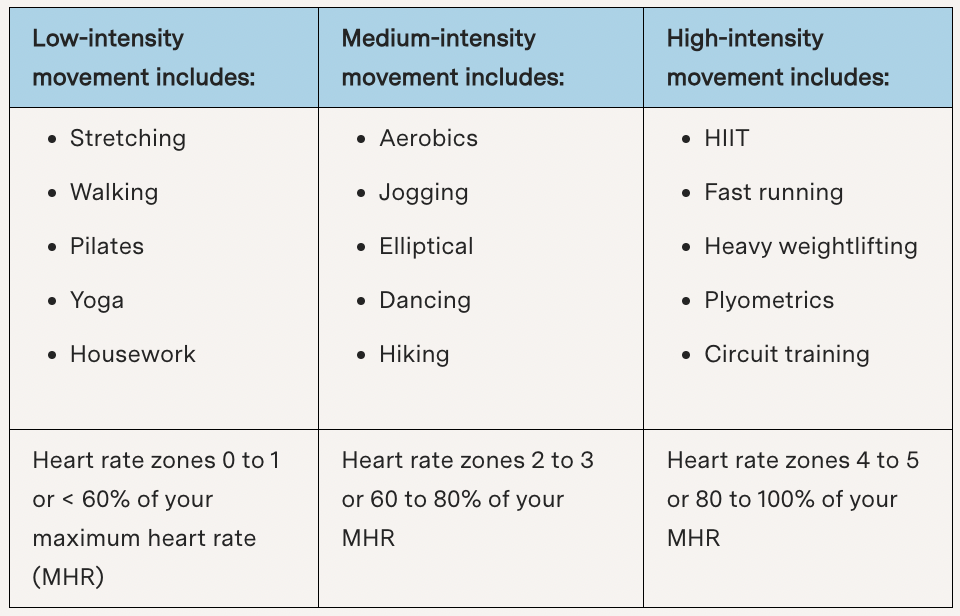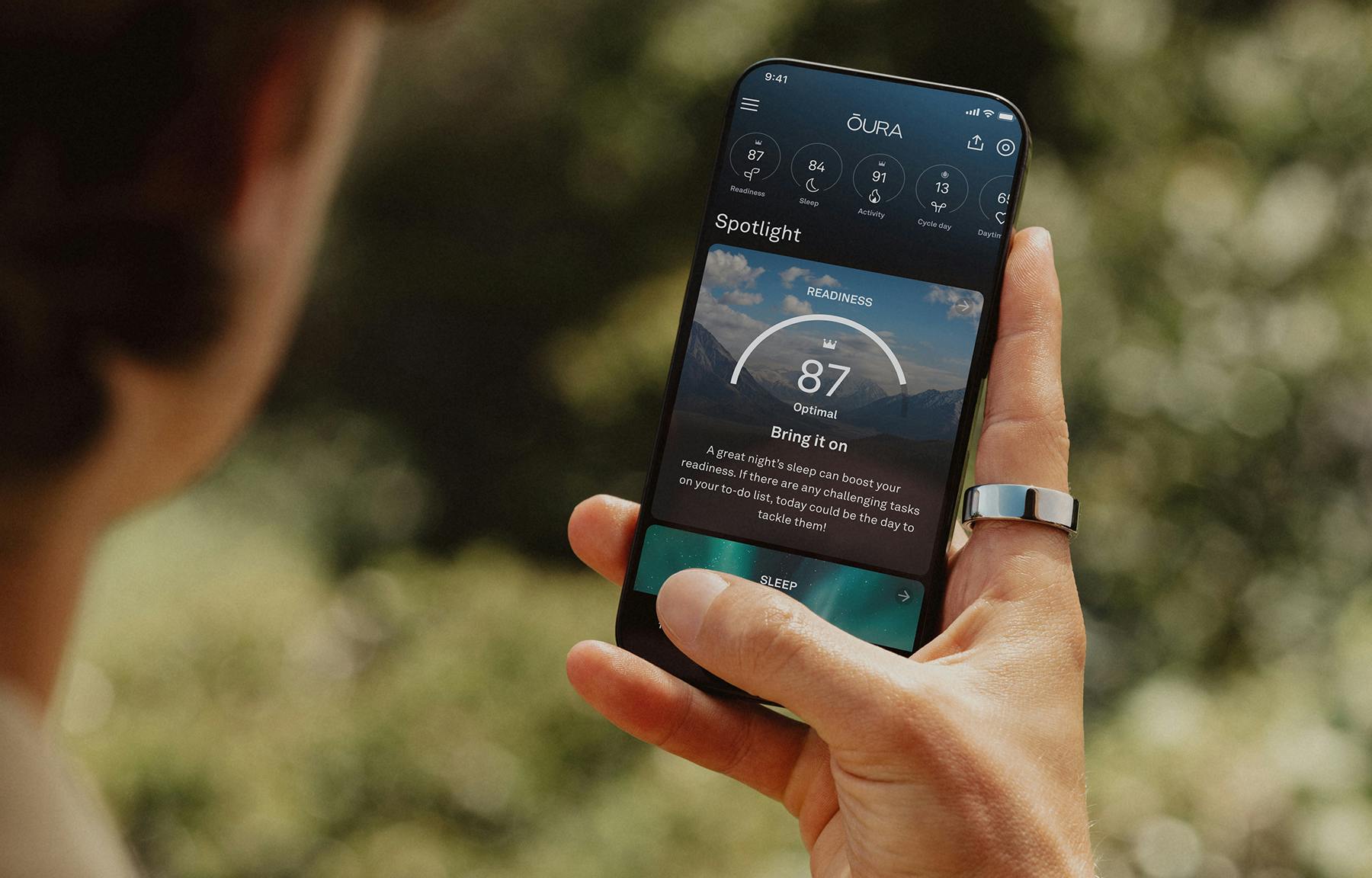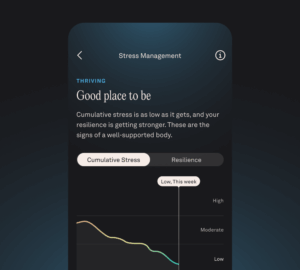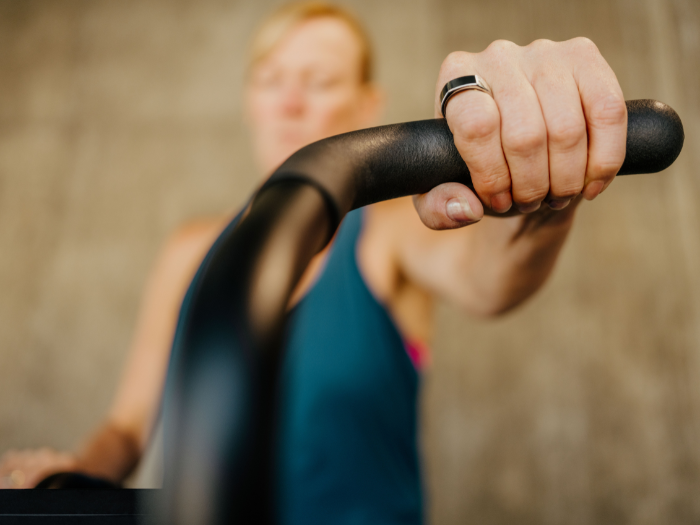It’s a common misconception that you have to push yourself to the limit to see real results from exercise. The harder, the better, right? In reality, a truly effective and sustainable exercise routine embraces a spectrum of intensities: low, medium, and high.
This isn’t just about hitting the gym; it’s about recognizing that every step, every stretch, every elevated heart rate contributes to your overall well-being. And with Oura, understanding and optimizing this varied movement has never been easier.
Low, Medium, & High Intensity Exercise Examples: A Quick Guide
Here are some examples of each type of workout intensity:

How Oura Powers Your Movement Insights

Your Oura Ring does more than track your workouts; it also categorizes them into their intensity, gives you a calorie burn estimate, and shows your heart rate during the activity. Below, learn more about how Oura can help you monitor your exercise intensity:
Activity Heart Rate
Oura captures your heart rate with higher precision during physical activity, giving you a clear picture of your exercise intensity. This data appears as an orange line on your heart rate graph in the app, and it helps calculate calories burned based on activity type, duration, and intensity.
RELATED: Why Do Heart Rate Zones During Exercise Matter?
Heart Rate Zones
Oura categorizes your heart rate into six zones, based on your age-adjusted maximum heart rate. Each zone corresponds to a different intensity level, from 0 to 6. These are grouped into cardiovascular (roughly zone 3 or higher) or metabolic (roughly zone 0 to 3) benefits. Spending time in all six heart rate zones positively impacts your health.
LEARN MORE: All About Heart Rate Zones
Automatic Activity Detection (AAD)
Oura automatically detects over 40 activities, meaning you’ll get insights into your daily movement even if you forget to log a workout. The app classifies the activity type, estimates intensity based on your heart rate, and assigns an accurate calorie burn estimate. This way, you can stay focused on your day while still capturing meaningful data.
Calorie Burn Estimates
Whether automatically detected or manually entered, Oura uses a combination of heart rate, duration, and activity type to estimate your calorie burn. If heart rate data is available, the estimate becomes more precise, reflecting the real intensity of your workout.
The Underrated Power of Low & Medium Intensity Exercise
You’ll likely notice on the Oura App that most of your daily movement comes from low-intensity activities, such as walking to the coffee shop, doing housework, or taking the stairs. That’s fantastic—it shows you’re staying active throughout the day, which is essential for your overall health.
| Member Tip: Noticing that you don’t move much throughout the day? Turn on inactivity alerts for a friendly reminder to stretch your legs after 50 minutes of inactivity. |
The benefits of low- and medium-intensity exercise include:
 1. It calms your system, activating your “rest and digest” parasympathetic system.
1. It calms your system, activating your “rest and digest” parasympathetic system.
Low-intensity exercise activates the parasympathetic nervous system, also known as the “rest-and-digest” mode. When this system is activated, your heart rate and blood pressure lower, and important autonomic functions, like digestion, occur.
In other words: Your body enters a state of relaxation. As Lauren Roxburgh, a certified trainer, movement and fascia expert, and founder of the Aligned Life Studio, states, “the more time you spend in this state, the healthier you are.”
READ MORE: Your Path to Inner Peace: 10 Ways to Improve Vagal Tone & Reset Your Nervous System
2. It boosts your heart health.
Walking and other types of low-intensity exercise have consistently improved markers of heart health. A meta-analysis published in the European Journal of Epidemiology revealed that walking for 30 minutes a day, five days per week, decreases the risk of coronary heart disease by 19 percent.
| Member Tip: Monitor your heart health using Cardio Capacity and Cardiovascular Age. |
3. It’s accessible for most people.
Low-intensity exercise is suitable for a wide range of people, regardless of age, injury recovery, pregnancy status, or fitness level.*
In fact, one study found that low-intensity exercise serves as an entry point into fitness and may prevent cardiovascular events in people with low fitness levels. Even if you’re not a big exerciser, engaging in low-intensity exercise like walking can have substantial health benefits.
*Always check with your healthcare provider before starting a new exercise routine.
4. It can promote high-quality sleep.
Low-intensity exercise is associated with improved sleep quality. Studies show that exercise reduces sleep latency—the time it takes to fall asleep. In one study in the journal Sleep Health, researchers found that low-impact, low-intensity physical activity improved multiple markers of sleep quality.
| Member Tip: On the Oura App, you can see if your workouts improve your sleep quality by using Tags and Discoveries. |
5. It can supercharge your recovery.
Exercising in heart rate zones 0 to 2, known as «recovery zones,» can boost your recovery by increasing blood flow, which helps to remove lactic acid and metabolic waste from your muscles. It also helps reduce post-workout muscle soreness by keeping your muscles flexible during the post-workout recovery period, speeding up the overall recovery process.
RELATED: How Sleep Helps Muscle Recovery and Growth
Unleash Your Inner Athlete: The Benefits of High-Intensity Exercise
1. It can boost your cardiorespiratory fitness.
To boost your fitness levels, high-intensity exercise is key. It pushes your cardiovascular system to deliver more oxygen to your muscles, leading to adaptations like increased capillary density, improved cardiac output, enhanced oxygen extraction, and better mitochondrial function. These changes significantly enhance cardiovascular fitness.
A 2014 study in the British Journal of Sports Medicine found that high-intensity training was twice as effective as moderate-intensity exercise for improving cardiorespiratory fitness.
| Member Tip: VO2 max is a key marker of cardiorespiratory fitness, and you can track it on Oura. See if incorporating more high-intensity workouts helps you improve this metric. |
2. It’s time-efficient for busy lives.
You might only have spent a minute or two in heart rate zone 6 on the Oura App, even if your workout felt intense. This can seem minimal compared to your low- and medium-intensity activity, but that’s normal. The more intense the workout, the shorter it needs to be.
For example, Tabata, a type of high-intensity exercise, involves 20 seconds of all-out effort followed by 10 seconds of rest, repeated for eight rounds, totaling just four minutes. Despite its brevity, a clinical trial showed that Tabata improved speed, VO2 max, and anaerobic capacity by 28%, outperforming moderate-intensity workouts.
3. It can promote fat burning and ignite your metabolism.
High-intensity exercise promotes fat burning through a metabolic effect called excess post-exercise oxygen consumption (EPOC), or the “afterburn.” During anaerobic exercise, you create an oxygen debt, leading to increased oxygen consumption and metabolic activity after your workout. This process replenishes oxygen, clears byproducts, and repairs muscles.
A 2011 study found that participants burned 112 calories during a six-minute HIIT workout but continued to burn calories for 24 hours due to EPOC, resulting in a total of 457 calories burned from the session.
4. It can optimize your hormones.
High-intensity exercise triggers favorable hormonal responses that aren’t as pronounced in low or moderate-intensity workouts. During HIIT, your body releases hormones like testosterone, insulin, growth hormone, and catecholamines (adrenaline and noradrenaline), which support muscle growth, fat metabolism, insulin sensitivity, and exercise performance.
A 2017 study showed that HIIT counteracted elevated glucose, insulin, and free fatty acids in male participants, helping maintain insulin sensitivity even in an insulin-resistant state.
5. It can increase strength, power, and muscle mass.
High-intensity exercise activates more motor units and muscle fibers, promoting better muscle recruitment, hypertrophy, and neural adaptations. These changes enhance muscle strength, force, and power. One study concluded that high-intensity training is “an efficient training protocol, which takes less time and produces a better improvement in anaerobic power.”
READ MORE: How Sleep Helps Muscle Recovery and Growth
How Much Low, Medium, and High-Intensity Activity Do You Need Per Week?
 According to the World Health Organization (WHO), adults should aim for:
According to the World Health Organization (WHO), adults should aim for:
- At least 150–300 minutes of medium-intensity aerobic physical activity or 75–150 minutes of high-intensity aerobic physical activity per week.
- Muscle-strengthening activities at medium or high intensity on two or more days a week.
The duration changes depending on the intensity of the exercise performed. Experts agree that combining low-intensity, medium-intensity, and high-intensity activity is optimal.
To help you visualize what a balanced week could look like, here’s a sample weekly workout routine that incorporates various intensities:
- Monday: 60-minute zone 2 walking.
- Tuesday: 45-minute zone 4 full-body weight-lifting.
- Wednesday: 30-minute zone 2 cycling.
- Thursday: 15-minute zone 5 HIIT workout.
- Friday: 60-minute zone 2 yoga class.
How much low or high-intensity exercise you do depends on your current fitness level, physical capabilities, goals, age, and other factors. Ideally, follow a workout routine that keeps you healthy and active—and one that you can maintain over time.
RELATED: All Movement Counts: Oura Announces New Partnerships with Leading Fitness and Mindfulness Platforms











